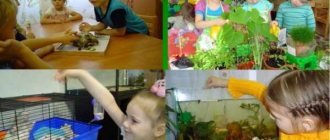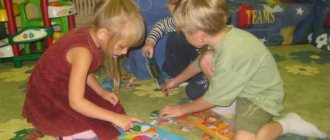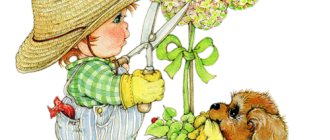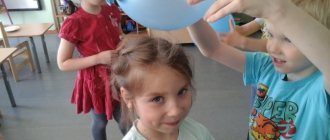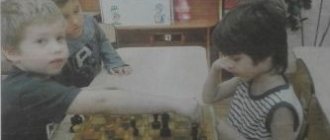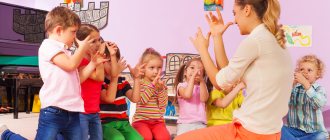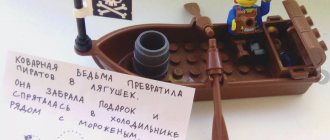Independent activity of children during a walk and management of it
Valentina Shishkoedova
Independent activity of children during a walk and management of it
(2nd slide)
Independent activity of children is one of the main models for organizing the educational process of preschool
children - free activity of pupils in a subject-development educational environment created by teachers, ensuring that each child chooses an activity based on his interests and allows him to interact with peers or act individually;
- activities of students organized by the teacher aimed at solving problems related to the interests of other people.
(3rd slide)
To organize
independent activities of children, it is necessary to create conditions: attributes, take-out material, tools for work .
The environment should provide children with the opportunity to act individually or together with peers, without imposing mandatory joint activities .
A special place in walks is occupied by children's independent play activities , in which the knowledge acquired in the lesson is consolidated. The development of relationships between children is provided: bringing them together for joint games, fostering a careful attitude towards toys, teaching order in the play space.
(4th slide)
Independent play activities during a walk are carried out under the control and guidance of a teacher . During the walk , the teacher can see and take into account the individual characteristics of the children . A walk makes it easier for a child to establish friendly communication with an adult and strengthen his trust in the teacher.
The teacher's personality-oriented approach contributes to the development of friendly relationships and the formation of a positive emotional mood in children .
(5th slide)
Children themselves choose what to do, while the teacher plays the role of director of children's
activities . At primary preschool age, a child cannot yet occupy himself for a long time, so independent activity at this age is short-lived, periodic and requires constant direction from a teacher.
(6th slide)
With age,
children's interests change : starting from middle age, children prefer the company of peers. Therefore, there is more variety in independent activities , but throughout preschool childhood the child’s main activity remains play. During a walk, older children can independently organize outdoor games, learned with the teacher, they can come up with new games, taking as a basis a plot from a book they read, from a movie they watched, or from life.
(7th slide)
Also, during
the walk, children pay a lot of attention to role-playing games, the content of which becomes more complex as the children . In this way, the problems of social and communicative development of children . The teacher can get involved in the activities of children in cases of conflict situations that require the intervention of an adult, or, if necessary, help a particular child join a peer group.
(8th slide)
The teacher must
supervise the children’s independent play activities : ensure their complete safety, teach them how to use aids in accordance with their intended purposes, and constantly monitor their activities throughout the walk . The teacher makes sure that all the children are busy, not bored, and that no one gets cold or overheated. those children who run a lot to participate in calmer games.
(9th slide)
Thank you for your attention.
Organization and conduct of walks in the senior group of kindergarten
Experience as a preschool teacher.
Methodology for organizing and conducting walks in the senior group Relevance of the topic: Currently, the task of preserving and strengthening the health of children, both physical and mental, introducing them to a healthy lifestyle and mastering modern health-saving technologies is one of the most significant and priority ones. Most modern children rarely communicate with nature. do not come into contact with it, this deprives them of the opportunity to know and feel it not only with their eyes, but also with other senses. By communicating with nature, children could not only get psychological relief, but also get a positive emotional mood and improve their health. Nature is a rich storehouse, invaluable for the intellectual and speech development of a child. The goal is to improve health, prevent fatigue, physical and mental development of children, and restore the functional resources of the body that have been reduced during activity. Objectives: • to provide a hardening effect on the body in natural conditions; • help improve the level of physical fitness of preschool children; • optimize the motor activity of children and promote the cognitive, speech, artistic, aesthetic, social and personal development of children. Children's stay in the fresh air is of great importance for the physical development of a preschooler. Walking is the first and most accessible means of hardening a child’s body. It helps to increase its endurance and resistance to adverse environmental influences, especially colds. During the walk, children play and move a lot. Movement increases metabolism, blood circulation, gas exchange, and improves appetite. Children learn to overcome various obstacles, become more agile, dexterous, courageous, and resilient. They develop motor skills and abilities, strengthen the muscular system, and increase vitality. A walk promotes mental development, as children gain a lot of new impressions and knowledge about the world around them. Types of walks (at the venue): · on the site of the Institution; - walking walks outside the Institution site (senior preschool age at a distance of up to two kilometers); - in the functional premises of the kindergarten (on activated days). Types of walks by content: · Traditional, which includes children’s work activities (cleaning up leaves, snow, etc.), active and quiet games, etc.;; · Thematic: consisting of observations and conversations on a specific topic (animals, clouds, trees, city transport, etc.), can be a street theater performance, a quest with overcoming simple obstacles - requires a pre-prepared script; · Targeted (conducted from the second junior group with access beyond the kindergarten); · Excursion (conducted systematically from the middle group at least once a month); · Hiking, hiking (carried out with children of senior preschool age 1-2 times a year). The duration of walks on the street The daily routine of the kindergarten provides for a daily daytime walk after classes and an evening walk after afternoon tea. The time allotted for walking must be strictly observed. Its total duration is 4 - 4.5 hours. To achieve a healing effect in the summer, the daily routine provides for children to spend maximum time in the fresh air with breaks for meals and sleep. During the winter period, outdoor walks are carried out 2 times a day: in the first half of the day - before lunch, in the second half of the day - before the children go home. In order to prevent hypothermia of body parts (face, arms, legs) in cold weather, it is recommended to send children to a heated vestibule for heating for no more than 5-7 minutes. Winter walks in kindergarten for children under 4 years old are held at temperatures down to -15°C, for children 5-7 years old at temperatures down to -20°C. -The time for each age group to go for a walk is determined by the mode of education and training. Walking is prohibited due to wind force exceeding 15 m/s. Walk structure: 1. Observation. 2. Outdoor games: 2-3 games of high mobility, 2-3 games of low and medium mobility, games of children’s choice, didactic games. 3. Individual work with children on the development of movements and physical qualities. 4. Children's labor on the site. 5. Independent play activity. The sequence of structural components of a walk may vary depending on the type of previous activity. If the children were in an activity that required increased cognitive activity and mental stress, then at the beginning of the walk it is advisable to conduct outdoor games, jogging, and then observations. If there was a physical education or music lesson before the walk, the walk begins with observation or quiet play. Each of the required components of the walk lasts from 7 to 15 minutes and is carried out against the background of independent activity. Observation A large place on walks is given to observations (pre-planned) of natural phenomena and social life. Observations can be carried out with a whole group of children, with subgroups, as well as with individual children. At a younger age, observations should take no more than 7-10 minutes and be bright and interesting; at an older age, observations should last from 15 to 25 minutes. They should be carried out daily, but each time children should be offered different objects to consider. Objects of observation can be: • Wildlife: plants and animals; • Inanimate nature: seasonal changes and various natural phenomena (rain, snow, flowing streams); • Adult labor. Observations of the work of adults (janitor, driver, builder, etc.) are organized 1-2 times a quarter. Types of observation: • Short-term observations are organized to formulate information about the properties and qualities of an object or phenomenon (children learn to distinguish shape, color, size, spatial arrangement of parts and the nature of the surface, and when familiarizing themselves with animals - characteristic movements, sounds made, etc. • Long-term observations are organized to accumulate knowledge about the growth and development of plants and animals, about seasonal changes in nature. At the same time, children compare the observed state of the object with what it was before. Motor activity The leading place during the walk is given to games, mainly outdoor ones. They develop the basic movement, relieves mental stress from activities, and develops moral qualities. The choice of game depends on the time of year, weather, air temperature. On cold days, it is advisable to start a walk with games of greater mobility associated with running, throwing, jumping. Fun and exciting games help children better tolerate cold weather.In damp, rainy weather (especially in spring and autumn), sedentary games that do not require a lot of space should be organized. Games with jumping, running, throwing, and balance exercises should also be carried out on warm spring, summer days and early autumn. During walks, folk games with objects such as ring throw, skittles can be widely used, and in older groups - elements of sports games: volleyball, basketball, badminton, table tennis, football, hockey. In hot weather, water games are held. Time for outdoor games and physical exercises during a morning walk: in junior groups - 6 - 10 minutes, in middle groups - 10-15 minutes, in senior and preparatory groups - 20-25 minutes. On an evening walk: in junior and middle groups - 10-15 minutes, in senior and preparatory groups - 12-15 minutes. Every month, learning 2-3 exercises (repetition for a month and consolidation 3-4 times a year) At a younger age, games with text (imitation of the actions of the teacher) are recommended. In the middle group, the teacher distributes roles among the children (the role of the driver is performed by a child who can cope with this task). In the senior and preparatory groups, relay races, sports games, and games with elements of competition are held. Outdoor games end with walking or low-mobility play, which gradually reduces physical activity. Children are not allowed to walk for long periods of time without moving. Children with reduced mobility and low initiative require special attention and should be involved in outdoor games. Labor activity of children on the site Labor activity during a walk is of great educational importance. You can see the forms of organizing children's work on the screen. Individual work assignments are used in all age groups of the kindergarten. Collective work makes it possible to develop work skills and abilities simultaneously in all children in the group. During collective work, the ability to accept a common goal of work, coordinate one’s actions, and plan work together is formed. In the younger group, children receive individual assignments consisting of one or two labor operations, for example, taking bird food and putting it in a feeder. The teacher takes turns involving all the children in feeding the birds. Or, for example, collecting pebbles for crafts. Work is organized as “work nearby”, while children do not experience any dependence on each other. In the middle group, two subgroups can work simultaneously and carry out different work assignments; The teacher's constant attention to the quality of work is required; showing and explaining the entire task are sequential steps. In older children, it is necessary to develop the ability to accept a work task, present the result of its implementation, determine the sequence of operations, select the necessary tools, and independently engage in work activities (with a little help from the teacher). Individual assignments become lengthy, for example, collecting and decorating a herbarium. Organization of individual work: - in accordance with calendar planning, the teacher carries out individual work on the cognitive - speech, social - communicative, physical or artistic - aesthetic development of children; — for this purpose, all materials and equipment necessary for the walk are prepared. Individual work during the walk is carefully planned. It is aimed at consolidating any skills, learning a physical exercise with one or more lagging children, practicing sound pronunciation, memorizing poetry, consolidating material in all sections of the program, and developing moral qualities. It is important that the child with whom individual work is carried out understands its necessity and willingly completes the proposed tasks. Children's independent activities during walks also require competent guidance. During independent play activities, children reflect the impressions received in the process of educational activities, excursions, everyday life, and acquire knowledge about the work of adults. This happens in the process of role-playing games. One type of creative games is construction games with natural materials: sand, clay, small pebbles, etc. To organize independent activities, it is necessary to create conditions: attributes, external materials, tools for work. It is necessary to comply with sanitary and hygienic requirements for the storage and placement of removed material. “The world surrounding a child is, first of all, the world of nature with an endless wealth of phenomena, with inexhaustible beauty.” V.A. Sukhomlinsky Used literature: 1. Voronkevich O. A. Welcome to ecology 2. Komarova T. S. Classes in visual arts. 3. Kondratyeva N. N. Children's environmental education program “We” 4. Makarova L. P. Theatrical holidays for children 5. Nikolaeva S. N. Young ecologist 2004 6. Pavlova L. Yu. Collection of didactic games 7. Skorolupova O. A. Classes with children on the topic “Autumn” 8. Stepanenkova E. Ya. Collection of outdoor games for children 2-7 years old 9. Shchetkin A. V. Theatrical activities in kindergarten
We recommend watching:
Synopsis of a comprehensive educational program for the development of fine motor skills and coordination of finger movements in the senior group Synopsis of a lesson on the surrounding world in the senior group with a presentation Synopsis of the organization of household work "Book Workshop" in the senior group Synopsis of direct educational activities on the development of speech and the surrounding world ( older
Similar articles:
Nurturing cognitive interests in children of senior preschool age
Identification of cognitive interests in preschool children
Formation of cognitive interest in mathematics among older preschoolers
Cultivating cognitive interest in nature in children of senior preschool age
Cultivating cognitive interest in book graphics in children of senior preschool age
Educational games for a walk
If we look at any playground, we will see, as a rule, the same picture: children dig in the dirty sand, slide down a dilapidated slide or climb onto a rickety ladder, and mothers chat on a nearby bench, only occasionally glancing towards their children : whether they got into a fight, fell over, or ate too much sand. For some reason, parents are sure that a walk is their time of legitimate rest from their child, and their responsibilities boil down only to monitoring his safety. Of course, the baby needs time to independently explore the world, to play with other children, but it often happens that the children are clearly bored or, conversely, overexcited and unable to play on their own, and the mother only about At the same time, the same mothers constantly complain that they do not have enough time for anything in general, and in particular for activities with the child. But it is a walk that opens up unique opportunities for activities with children.
You are supporters of Glen Doman's ideas
and do you like to show your baby cards with signatures? Amazing! Go to the nearest forest park, to the river bank, to the boulevard, or just to a green corner of the yard. Write on the cards the words “earth”, “grass”, “tree”, “dandelion”, pine cone, “bark”, “shore”, etc. and place them directly on the ground, attach them to tree trunks, lean them against flowers. Now take your baby around this magical clearing, reading the cards to him. Even a ten- to eleven-month-old baby, not to mention older ones, will be delighted with such a game. An older child can be invited to play in the “museum of wildlife”, let him place the cards correctly in front of the “exhibits”. If your baby can’t read yet, help him: “Where is the dandelion? Take the signature to him!” “Here I write: “pine”, and for now you look for where to attach it.” A two or three year old will be happy to take part in collecting a herbarium in the summer or collecting seeds in the winter. You will then sort all the samples together, arrange them and sign them.
Well, where else if not to study the basics of geography and astronomy
? Take a compass with you and explain to your child how to determine the cardinal directions, and at the same time tell us how to navigate without a compass. Four or five year olds can already be told how to use a plan and a map of the area (this is written very well and in detail in the book “Educational Games” by B. Nikitin). You can even go on a real little hike by determining the route in advance using a map. On a clear winter evening, when it gets dark early, try to find the North Star, Ursa Major, and other constellations in the sky. Show your baby the Moon in different phases and tell them about their changes. Find an open area where you can easily see the sunset. This sight will shock even the tiniest kids.
Birds and insects
- the most accessible representatives of the fauna for city residents. Grab crumbs for ducks and pigeons, make a feeder for bullfinches and tits in the park. Teach your child to quietly watch birds. It's good to come regularly to the same place. For example, in early spring you can watch how drakes take care of ducks, in summer you can admire ducklings, and in autumn you can watch how ducks prepare to fly away. You can also remember the fairy tale about the Gray Neck.
Find an anthill and observe its inhabitants, tell your child how hardworking ants are, how they live as a big happy family. If you take a magnifying glass with you, you can carefully examine the ant or other insect. Just do not allow your child to torment insects and birds under any circumstances. But you can take the caterpillar home, put it in a jar and try to turn it into a butterfly. Be sure to pay attention to which leaves the caterpillar was sitting on: they should be fed to it.
you can do math while walking
. Well, where else if not in the forest to master the concept of ten? Collect, for example, several dozen cones or pebbles, arrange them in previously prepared boxes or simply on large leaves - here is a mathematical guide for you. Sandy and asphalt areas are suitable for geometry classes. You can draw with a stick or chalk, and if several children get together, invite them to turn into geometric shapes themselves: by extending strings to each other, the kids will be able to make a triangle, square, rhombus... If you grab a tape measure or folding meter from home, you can start measuring distances, calculation of perimeters and areas (for example, a site for the construction of a castle)
If you value Montessori ideas
, stock up on vessels of various sizes to pour and measure the amount of various liquids and bulk solids, you can also take a steelyard. A sandbox or the shore of a pond is an ideal place to study the concepts of many-little, heavy-light, liquid-solid. And fiddling with sand, water, small pebbles and cones will strengthen the baby’s fingers and develop fine motor skills.
You can try speaking as a child during a walk only in a foreign language.
(provided, of course, that you yourself speak it fluently enough or at least with correct pronunciation and without gross errors).
From time to time (but not very often, so as not to get tired) take paper and paints or pencils
and play “sketching artists.” Explain to your child how to sketch plants, animals, people, and draw landscapes. Just don’t demand similarities, let him draw as he wants. And if you also draw (not for the child, but next to him!), it will be absolutely wonderful. Then it will even be possible to arrange an exhibition.
Yard games
The children of our childhood are gradually passing away, and today’s children do not know how to organize group play at all. Therefore, on the playground it is worth trying to arrange general games for kids, from “loaf” and “stream” to lapta and “Cossack robbers”. Perhaps you know some rarer ancient games or you can come up with them yourself - so much the better. After all, in any group games, your child gains invaluable experience of communication and cooperation, which will be so useful to him in life.
And yet, the most important thing during a walk is the discoveries that your baby will make on his own, the communication experience that he will gain while playing with other children. Therefore, do not rush and do not impose your program on the child, but intervene tactfully and discreetly when you feel that the baby is already tired of having fun on his own.
